Friday, November 4, 2022
Check out these tips to make your current automations more effective and/or to create new automations that will up the profitability of your email program!
Note: I presented some of this content at the GURU Conference in November 2022, but due to time constraints I could not present all of it. So, if you saw me there, this post and it’s soon-to-be-published companion will give you the full story! Enjoy!
Automation refers to email messages which are triggered, typically by an action by the recipient. A welcome message which is sent immediately after someone opts-in to receive email from you is an automation. So is a cart abandonment email series. But these are just the tip of the iceberg when it comes to emails that can be automated.
I firmly believe that automation is the future of email marketing – and I have for a while now. Here’s a diagram from work I did for a client back in 2016 outlining how we would use automation to provide relevant content at each point in the prospect journey.

So why would you do this? Why would you take the time to set up automations instead of just ending ad hoc emails? There are a few reasons…

Done strategically, automated email marketing programs…
- provide passive income; it’s not quite ‘set-it-and-forget-it’ (more on that later), but it’s close. You set them up once, and they continue to deliver revenue on a regular basis for months or even years!
Side note: I had a client that was migrating from one marketing platform to another. I brought in a platform technical expert to help us. After he had migrated the dozens of automations they asked us to, he let us know that he had found one more. Although some of the images were no longer appearing and some links were broken, it had generated revenue for them in the past week. Did they want that migrated too? Of course they did!
- free up your staff’s time; instead of a never-ending crunch to just get email sent to drive revenue, they can focus on higher-value activities, like A/B split testing. Not only is it a better return on your human resources for the business, it’s more interesting day-to-day work for your team.
- increase the relevance of your content; the email messages are deployed when the recipient takes an action that triggers the send. In the world of the ‘the right message, at the right time, to the right recipient’ automation rules the day.
Oh, and one more benefit of automated email marketing programs…
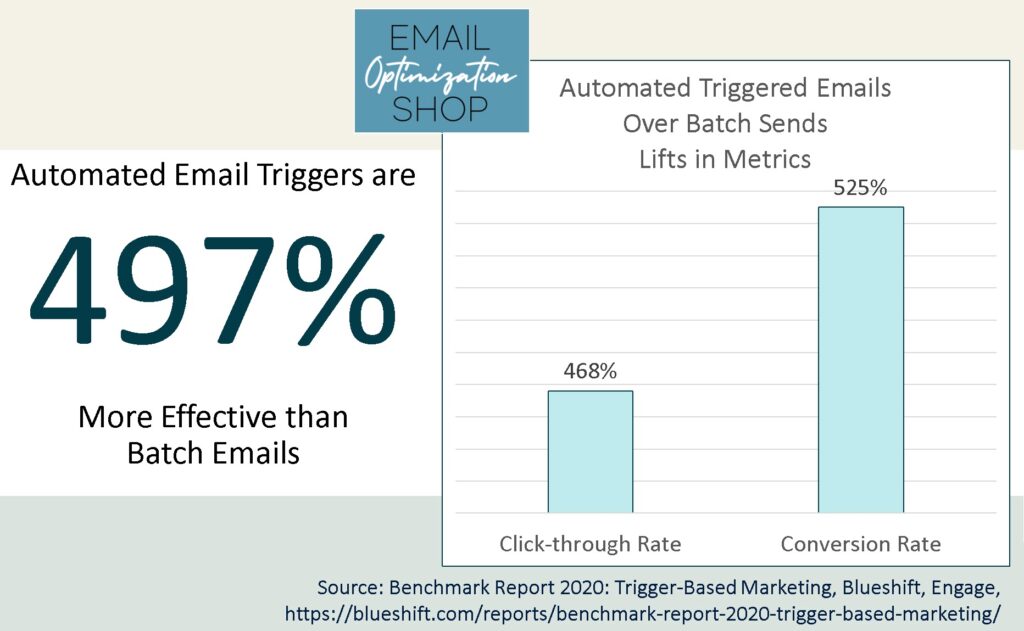
They perform better than batch, business-as-usual, or ad hoc emails. Nearly six-times better, according to a recent report from Blueshift.
Think about that a minute. If your average revenue-per-email (RPE) on an ad hoc email marketing campaign is $5, then a strategic automated email marketing campaign could deliver an RPE of nearly $30. If your business-as-usual email marketing conversion rates are currently running a healthy 2%, a 525% increase (as reported by Blueshift) would give you a 12.5% conversion rate on a strategic automated email marketing campaign.
Even if your lifts in performance of half of these amounts or less, that’s probably enough to earn you a raise, job security, and speaking gigs!
But here’s the rub…

So how do you make sure you’re automating an efficient email message or series? Here are some tips on where to begin…
There are a number of different prospect funnels out there, one I often use with my clients appears below. But no matter which one you use, starting at the bottom, closest to the conversion, is key. Because a 5% lift here will impact your bottom line sooner than a similar lift at the top of the funnel.
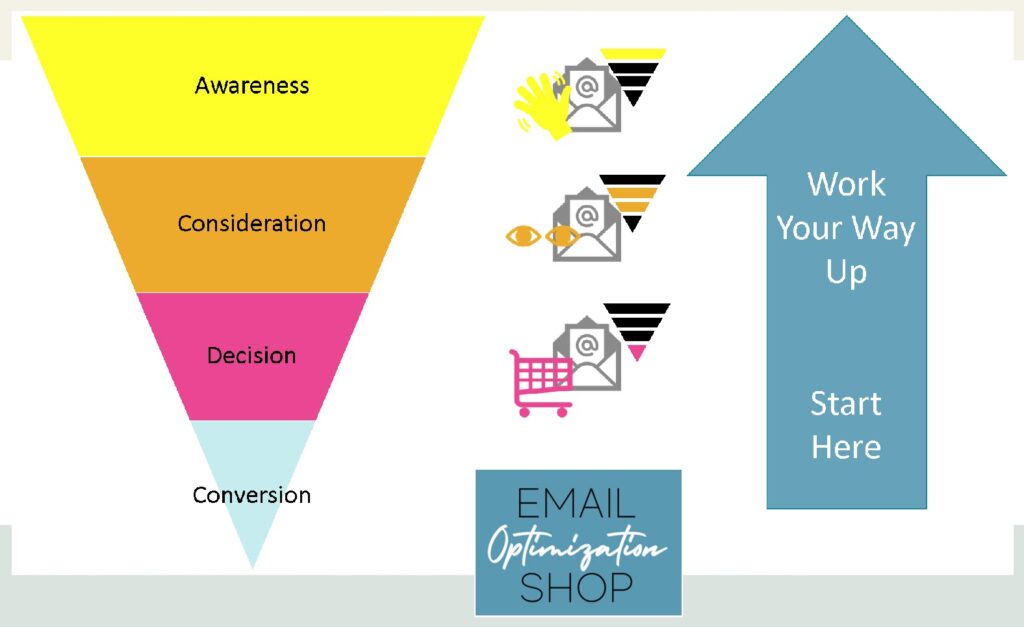
Bottom of Funnel
In the B2B world, this would include automated emails or series with content to help drive the decision, like pricing comparisons.
In the B2C world, this is where an automated cart abandonment campaign would be a natural fit.
Middle of Funnel
For B2B, this could include triggered messages with unique selling propositions, so that when prospects are considering different vendors, your organization makes the short list.
For B2C, an automated browse abandon series here can bring people who looked at an item but didn’t put it in their cart back to buy.
Top of Funnel
This is an awareness phase for B2B organizations; you’re sharing information like blog posts to educate your prospects and position your organization as an expert.
A welcome message would be appropriate for the B2C world; a strong one would strive to turn the new subscriber into a fan.
Where to Begin (A Case Study)
I like to look at emails that are already being sent manually and see if automating them makes sense.
I was doing an audit for a client, to analyze all the email marketing they were doing and make recommendations to boost bottom-line performance.
One of the email specialists told me that when she had time on Friday afternoons, she’d manually send a cart abandon email. She had to download data on who had items sitting in their carts, then upload this data to the marketing platform and trigger a generic ‘you left items in your cart’ email. She did this maybe once or twice a month, just when she had time.
When we looked at the performance of this single cart abandoned email, we got excited.
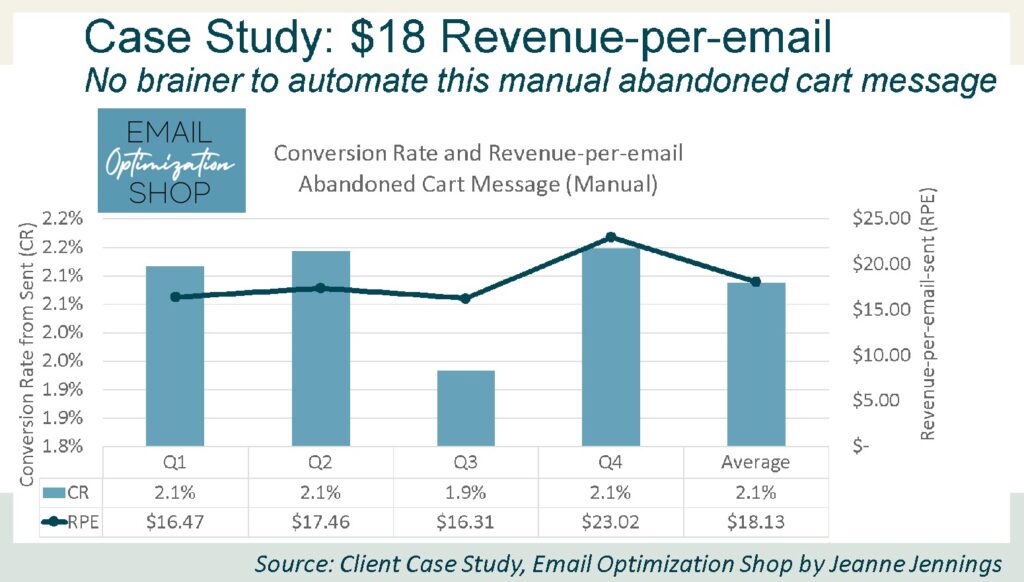
Yep. That manual program was generating an average of $18 for each email sent (RPE). What kind of an email rock star would you be if you could generate $18 for each email you send?
Initially we automated it exactly as it was, except for the timing – instead of having the emails sent in a batch each Friday, we had them sent individually based on a trigger, beginning at 3 hours after the cart was abandoned. We got an immediate lift over the $18 RPE, due to this new timing.
Later we worked on A/B split testing the creative and timing to further boost performance.
You know what a smart goal is, right? It’s:

Here are some examples from my work with clients:

A single email can only get you so much…
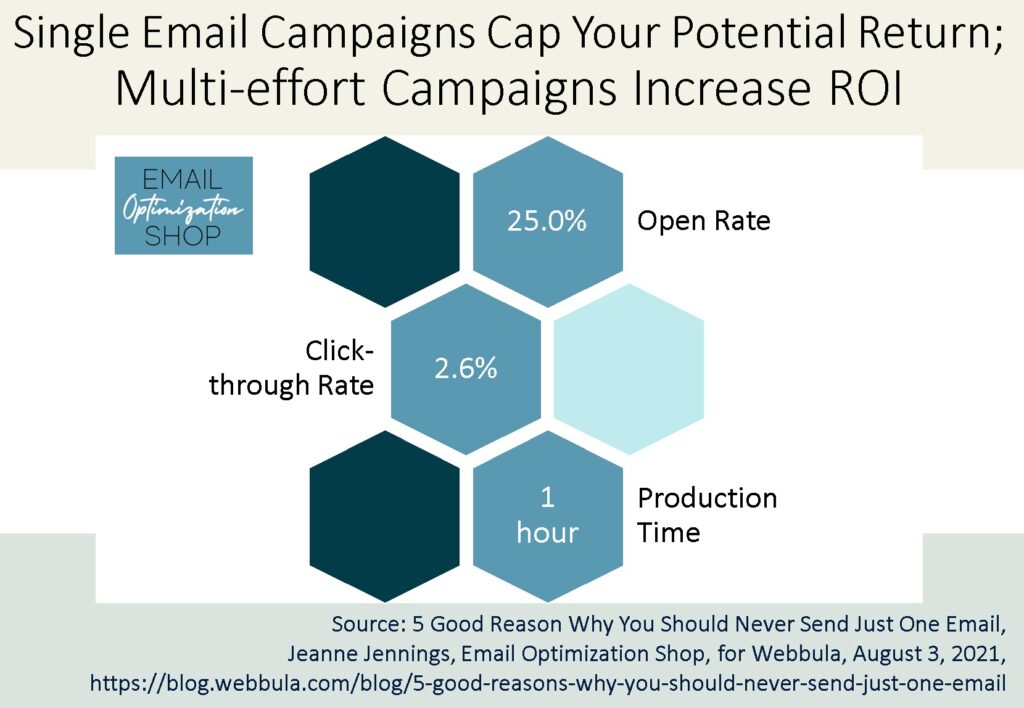
The statistics above are the reported average metrics for non-automated email messages – and they are actually pretty optimistic compared to what most companies are seeing (they are from pre-MPP data, so your open rate may be higher now).
A 25% open rate means that 75% of your recipients didn’t open your email.
A 3% click-through rate means that 97% of your audience didn’t click on your message.
This or something similar is likely the best you can expect from a single message. Automating a good message may increase this, but you’re still limited in your results.
And it takes at least an hour to create a single email message – probably longer.
But here’s the thing. If a single email message takes you X hours to create, a 5-email series won’t take you 5X hours.
And a strategic multi-effort series can significantly increase the reach of your campaign. For instance…
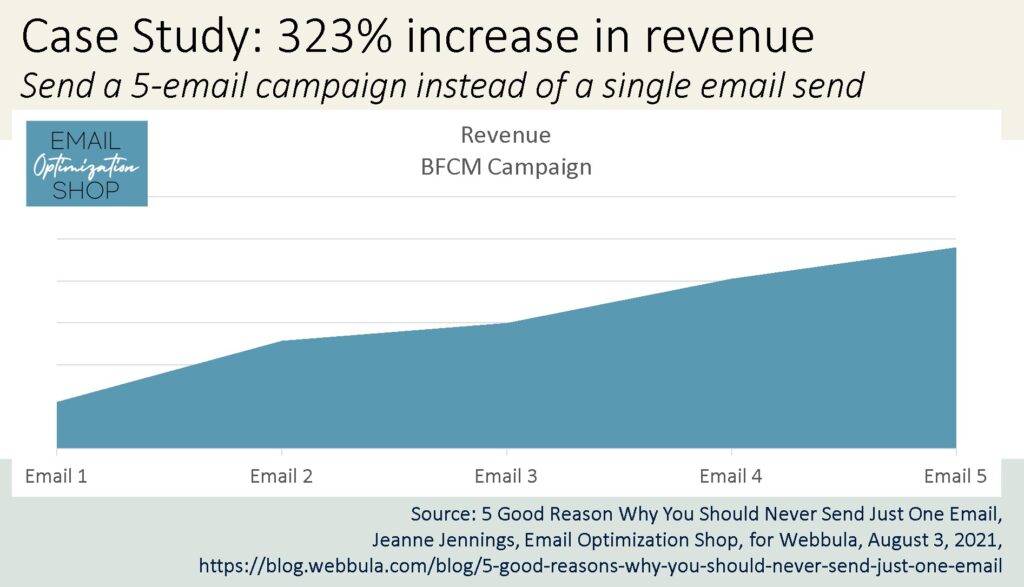
By sending more than one email we increased the revenue generated by 323%. If we just sent the first email, our total revenue would have been a lot less.
Sending the same email over and over again is not a series. The idea of a series is that each email has a different message and stands alone, but together they are greater than the sum of their parts.

So how do you come up with those key messages? You have to know understand what benefits your product or service will provide your audience. Here’s an example, from work with one of my clients a few years ago, in a campaign to help government procurement officers spend funds from the American Recovery and Reinvestment Act (ARRA).
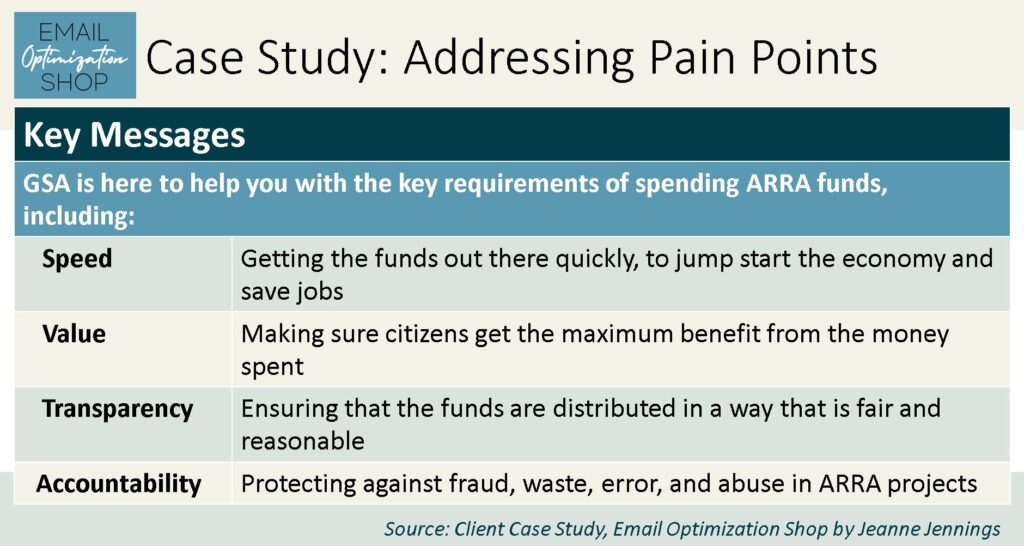
As you can see, we identified 4 key messages – these are basically 4 requirements for ARRA funds which the Government Services Administration (GSA, my client) was able to help government procurement officers comply with. And they formed the core of our messaging for this campaign.
It takes some thought and some time to come up with effective key messages. They need to be more specific than ‘we can help you do your job better.’ I guess it’s possible to do this quickly, but any extra effort spent to flesh out what you truly want and need to say to your audience usually benefits the end product.
Once you have your key messages, you need to turn them into a message map, like the one below.
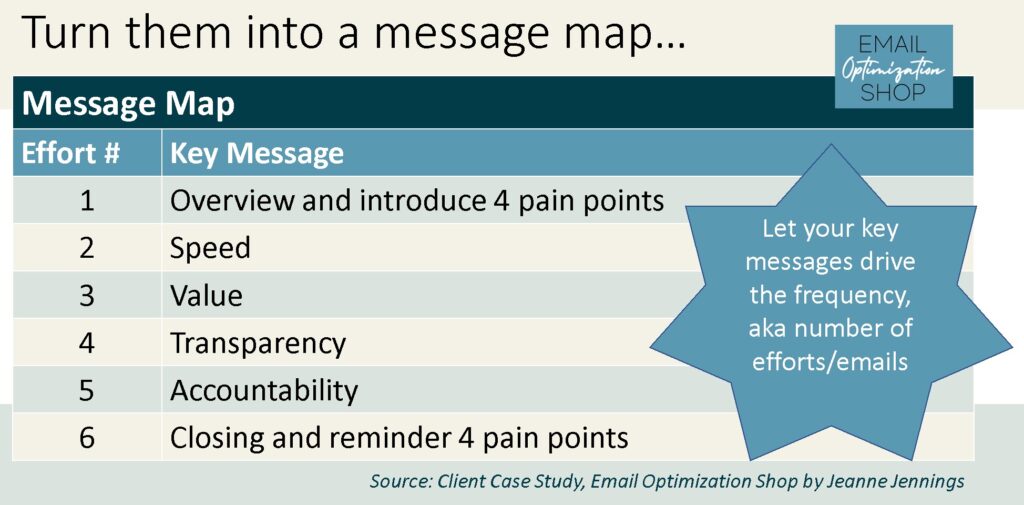
This isn’t difficult. My formula is always to bookend my key messages – I add emails at the beginning and end which touch on each of the key messages, without going into detail. Then I use the messages in between to go into detail on each of my key images, one per email.
And guess what – once you do this, you have the number of email messages or efforts in your series!
You always want your content to drive the number of email messages in your series. Think about it. You’d be hard-pressed to create 15 effective messages if you only have 4 key messages. And by the same token, if you decide on 3 messages and then have 7 key messages, you’ll be having to cut a few – or combine them, which often leads to information overload for readers.
You have your key messages, you’ve turned them into a message map, but you’re not done.
Now you have to figure out what your calls-to-action (CTAs) for each message are.
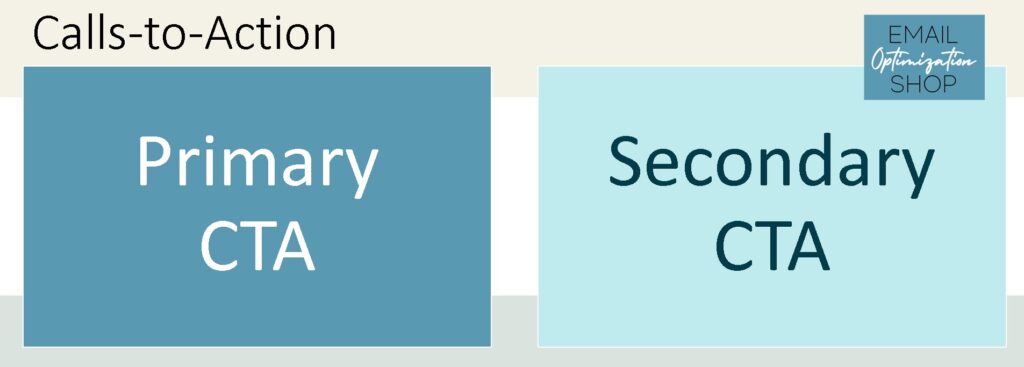
Every message in the series should have a CTA to your final goal for the series. But you may also want to have secondary CTAs, like to download a white paper, or learn more about a topic in the series. Here’s an example, the next step from the case study we’ve been using:
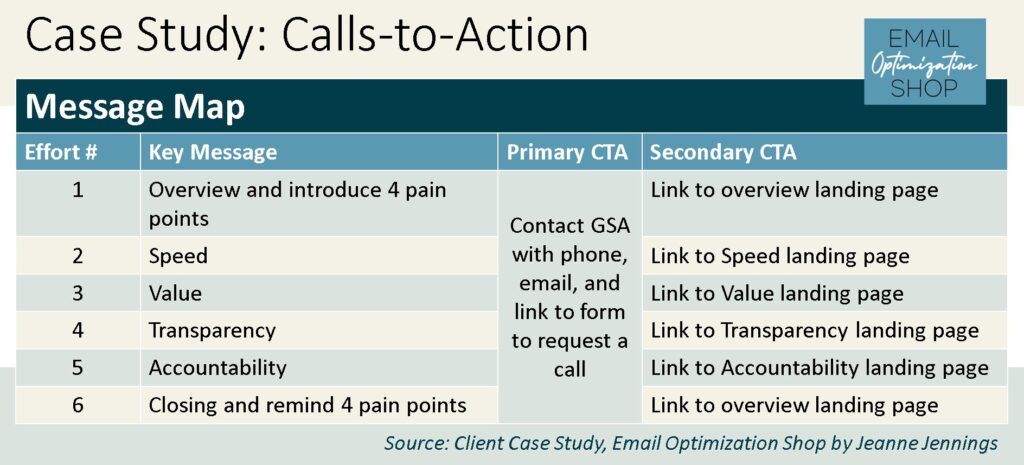
The primary CTA is what we want them to do to meet our goals – contact GSA. To make it easy, we include multiple ways to do that in each email message.
Our secondary CTA had to do with the key message of each email. Maybe the recipient wasn’t ready to contact GSA yet. So we had a landing page with more detail on each of our key messages, as well as a landing page for the overview emails. This way recipients could learn more about any key message that was of interest to them.
By the way, every landing page, in addition to having additional detail on its key message, along with the primary CTA – to contact GSA with ways to do that.
So, how are you doing? That’s a lot, right? How are automated emails so complicated? Not all of them are – but to optimize your bottom-line performance, these are the steps you can’t omit from the process.
And yet we’re not done. I’ll be back next week with 6 more tips for improving your automated email marketing messages. We’ll cover cadence, logic, reporting, and more. Stay tuned…
In the meantime, take a look at your existing automated email campaigns and see if you can improve them with these tips. Then relaunch them and let me know how it goes. You can iterate them again after the next 6 tips.
And if this all seems daunting… don’t throw up your arms. Email me and let’s talk. I do this day in and day out for clients, and I’d love to learn more about your automated programs and put together a proposal to help you optimize them.